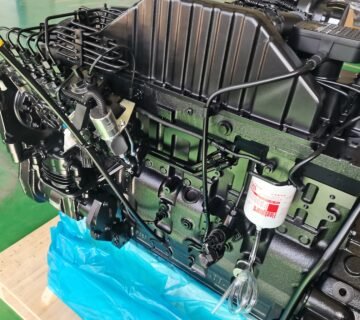How Long Do Cummins Diesel Engines Last? Factors That Maximize Lifespan
When investing in a diesel engine, longevity is a top priority. Cummins Inc., a global leader in diesel technology, has built its reputation on engines that combine rugged durability with peak performance. But how long can you expect a Cummins diesel engine to last? While the answer varies based on usage and maintenance, properly cared-for Cummins engines often exceed 1 million miles in heavy-duty applications. Let’s explore the engineering, maintenance practices, and real-world factors that define the lifespan of these powerhouse engines.

- Built to Endure: Engineering for Longevity
Cummins diesel engines are engineered with longevity in mind. Key components like the compacted graphite iron (CGI) block and forged steel crankshaft provide exceptional resistance to wear, even under extreme loads. For example, the Cummins X15 engine uses CGI, which is 75% stronger than traditional gray iron, ensuring the block withstands high cylinder pressures over decades of use.
Another critical factor is precision manufacturing. Cummins’ closed-loop machining processes ensure tolerances within 5 microns, reducing friction between moving parts. This attention to detail minimizes wear on components like pistons, rings, and bearings—directly extending the engine’s service life.
- Maintenance: The #1 Factor in Engine Longevity
While Cummins engines are built tough, their lifespan ultimately depends on adherence to a proactive maintenance schedule. Key practices include:
– Oil Changes: Using Cummins-approved synthetic oil every 15,000–25,000 miles prevents sludge buildup and reduces metal-on-metal wear.
– Fuel Filter Replacement: Dirty fuel injectors are a leading cause of premature failure. Replacing filters every 10,000 miles ensures clean fuel delivery.
– Cooling System Care: Regular coolant flushes (every 300,000 miles or 12 years) prevent corrosion and overheating.
A study by the American Trucking Associations found that fleets following Cummins’ maintenance guidelines achieved 1.2–1.5 million miles before major overhauls—twice the lifespan of poorly maintained engines.
- Application Matters: How Usage Impacts Lifespan
Not all Cummins engines face the same demands. A generator engine running at steady RPMs may last 20,000–30,000 hours (equivalent to 1 million+ miles), while a mining truck engine subjected to constant stop-start cycles and dust may require rebuilds sooner.
The Cummins QSK60, used in mining and marine industries, exemplifies adaptability. Its dual-stage filtration system protects against abrasive particles, while jacket water cooling maintains optimal temperatures in harsh environments. Such designs help even high-stress engines reach 800,000+ hours with proper care.
- Emissions Systems: Balancing Durability and Compliance
Modern Cummins engines integrate advanced emissions technologies like EGR (Exhaust Gas Recirculation) and SCR (Selective Catalytic Reduction). While these systems add complexity, Cummins ensures they’re robust. For instance, the Single Module™ aftertreatment on the X12 engine consolidates components, reducing failure points.
However, neglecting Diesel Exhaust Fluid (DEF) quality or ignoring DPF (Diesel Particulate Filter) regeneration cycles can lead to clogging and costly repairs. Fleet operators who follow Cummins’ emissions system maintenance protocols avoid 90% of related issues.
- Real-World Examples: Cummins Engines in Action
– Long-Haul Trucking: Schneider National reported Cummins ISX15 engines averaging 1.1 million miles before needing a rebuild, attributing this to strict oil sampling and turbo inspections.
– Agriculture: A Midwest farming cooperative’s Cummins QSL9 engines powered irrigation pumps for 15+ years, logging 25,000 hours with only routine valve adjustments.
– Emergency Generators: Cummins QSV91G engines at a Florida hospital have provided backup power since 2005, surviving hurricanes and salt air due to corrosion-resistant coatings.
- When to Rebuild: Signs Your Cummins Engine Needs Attention
Even the best engines eventually require refurbishment. Watch for these indicators:
– Excessive Blow-By: White smoke or oil mist from the breather suggests worn piston rings.
– Loss of Power:Clogged injectors or turbo lag may signal fuel system issues.
– Increased Oil Consumption:Burning more than 1 quart per 1,000 miles often points to internal wear.
Cummins’ ReCon® program offers cost-effective remanufactured engines, restoring performance to 95% of new engines at half the price.
- Tips to Extend Your Cummins Engine’s Life
- Monitor Fluid Quality: Use oil analysis kits to detect contaminants early.
- Avoid Short Trips: Let the engine reach operating temperature to prevent moisture buildup.
- Upgrade Air Intake Systems: High-efficiency filters protect against dust ingestion.
- Store Properly: Use fuel stabilizers and battery tenders during long idle periods.

Conclusion: A Cummins Engine is a Long-Term Investment
The lifespan of a Cummins diesel engine isn’t just a number—it’s a testament to intelligent design and disciplined care. While these engines routinely surpass 1 million miles in trucking or 30,000 hours in industrial use, their true potential is unlocked through proactive maintenance and operational awareness. By partnering with Cummins’ global service network and leveraging technologies like Connected Diagnostics, operators maximize uptime and longevity.
For industries where reliability is non-negotiable, Cummins delivers more than an engine; it delivers peace of mind. Explore Cummins’ diesel lineup today and discover how to turn robust engineering into decades of dependable service.





No comment